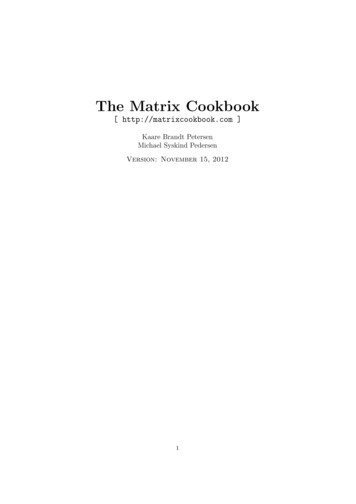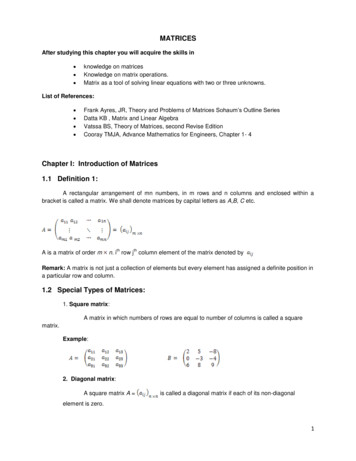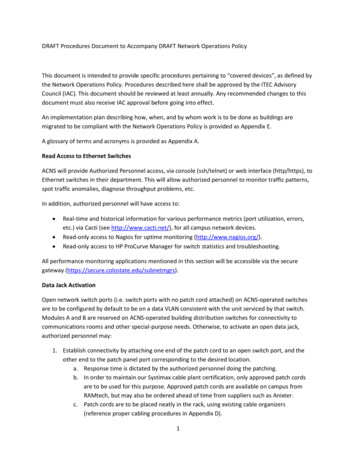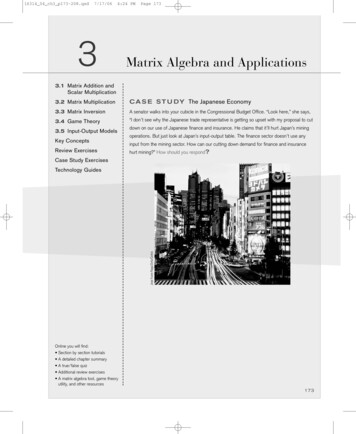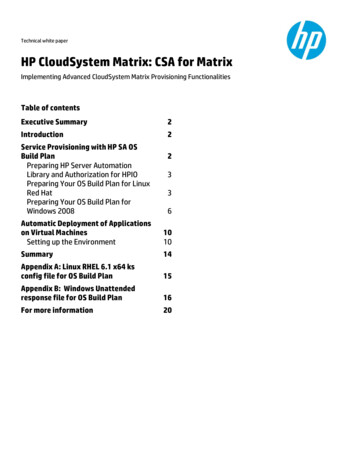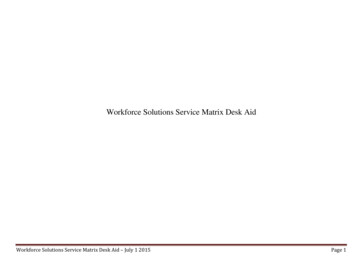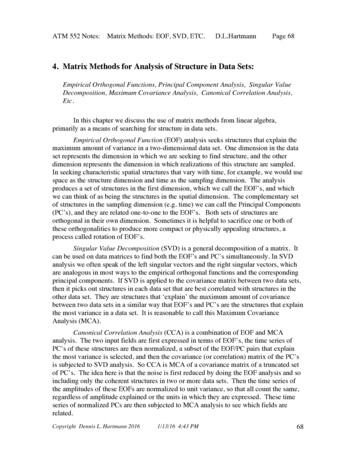
Transcription
Matrix to accompany draft Handbook for LSBApril 2011Draft SRA Indemnity Insurance Rules [2011] and Qualifying Insurer's Agreement (QIA)*Overview of Indemnity Insurance Rules and QIACSIIR1 Nature and effect of the existingprovisions (if applicable)The current Solicitors’ Indemnity Insurance Rules prescribe the compulsory professionalindemnity insurance arrangements for firms regulated by the SRA. The regulatedprofession engaged in private practice is required to secure professional indemnityinsurance complying with certain Minimum Terms and Conditions (MTC) of cover fromany of the qualifying insurers. The current rules (Solicitors’ Indemnity Insurance Rules2010) will remain in force in respect of claims made during the indemnity year ending on30 September 2011. The new rules (SRA Indemnity Insurance Rules [2011]) will comeinto force on 1 October 2011 and will cover claims made in the indemnity year ending30 September 2012.The rules require firms carrying on a practice in England and Wales to take out andmaintain professional indemnity insurance with “qualifying insurers”. The purpose of thecover is to provide clients with a basic level of protection in the event that a firm isnegligent or dishonest which results in the claimant suffering a loss.The QIA is the agreement that authorised insurers must sign to be able to offer qualifyinginsurance. The QIA includes the agreement, the ARP policy, the Indemnity InsuranceRules and the MTC. Under the terms of the QIA the insurers agree to: issue policies that comply with the MTC;participate in the ARP;report suspected dishonesty to the SRA;arbitration arrangements for disputes between insurers.1
CSIIR2 Are the provisions to be applied toABS? If so, why?Yes. The Legal Services Act 2007 requires a Licensing Authority’s licensing rules tohave appropriate arrangements as to professional indemnity cover. The draft rules aimto ensure that clients of an ABS receive the same level of protection as clients of atraditional firm of solicitors; and that the level of protection is proportionate to the risk.CSIIR3 Nature and effect of the proposedchangesThe draft rules are based on the existing (i.e. 2010) rules, but have been changed in anumber of respects as follows: the rules have been extended to apply to ABSs; ABSs are required to effect policies of qualifying insurance in the same way asother persons and entities; the period a firm can be in the Assigned Risks Pool (ARP) has been reduced from12 months to 6 months; minor consequential changes needed to reflect the future treatment of solepractitioners as recognised bodies; changes to the rules and MTC (many stylistic) to accommodate the HandbookGlossary.The draft QIA has been changed as follows: to clarify of insurers' obligations to provide information to the SRA; to remove the provision for the recalculation of ARP participation in the event ofinsurer insolvency.CSIIR4 How do these proposals impact uponthe regulatory objectives and theprinciples of better regulation?The Legal Services Act 2007 requires a Licensing Authority’s licensing rules to haveappropriate arrangements as to indemnity cover. By ensuring clients of an ABS receivethe same level of protection as those of a traditional firm, extension of the current rules toABS will: protect and promote the public interest; and protect and promote the interests of consumers.The SRA’s current arrangements for professional indemnity and compensation havebeen the subject of an independent review carried out by Charles River Associates(CRA).2
The changes to be introduced this year are the first stage in a three year plan aimed atrelieving the stresses that have built up over the last few years which have led to anunwillingness on the part of insurers to provide profession indemnity insurance tosolicitors, or to insurers restricting their participation to a limited volume of business or toonly certain types or sizes of firms. There is a significant risk that if these issues are notaddressed the market will not be willing to provide cover to certain segments of theprofession. This will impact the firms in those segments and the clients of those firmsthat wish to make a claim.The proposed changes are essential not only to improve the competitiveness of theopen-market arrangements but also to ensure that they are sustainable.We believe that the changes proposed meet the principles of better regulation and, inparticular, are proportionate to the risks to clients.* The QIA does not form part of the Handbook but parts of it do form part of the SRA's "regulatory arrangements" and as such changes require LSB approval.Specific proposals – Indemnity Insurance Rules and QIACSIIR5ProposalRelevant provisionsPurpose and desired outcome of thespecific provisionsCould the provisions conflictwith those of anotherregulator? If so, how will suchconflicts be addressed?Extension of theexistingSolicitors’IndemnityInsurance Rulesto accommodateABS.Changes made throughoutthe rules, as necessary. Inparticular, the SRA’s legaljurisdiction in relation to anABS is delineated in therules through the conceptof the ABS’s “regulatedactivities”.Purpose - to accommodate ABS withinthe SRA Indemnity Insurance Rules.Generally there will be noconflict with the arrangements ofother regulators. The SRA’slegal jurisdiction in relation to anABS is delineated in the rulesthrough the concept of theABS’s “regulated activities”.Desired outcome - to ensure that clientsof an ABS receive the same level ofprotection as clients of a traditional firmof solicitors; and that the level ofprotection is proportionate to the risk.Are theseprovisionsdependantupon aS:69Order?No3
An ABS which is a multidisciplinary practice (MDP) mayhave professionals who aresubject to the rules of more thanone regulator. Any potentialdifficulties which may arise inthis context are being resolvedthrough discussion with otherregulators and the adoption ofFramework Memorandum ofUnderstanding. We are alsoexploring the scope for closerfuture alignment of indemnityrequirements betweenregulators.CSIIR6Definition of“Eligible Firm”Rule 3.1Purpose - the definition has beenamended to limit the period a firm iseligible to be in the ARP from 12 monthsto six months. There are transitionalprovisions such that firms already in theARP on 30 September 2011 may beeligible to remain at ARP for the balanceof the period that they were eligible to bein the ARP when they entered the ARPi.e. 24 months for firms entering in the2009/10 indemnity period or 12 monthsin respect of the 2010/11 indemnityperiod. This is part of the plannedphasing out of the ARP as a provider ofpolicies of qualifying insurance.No.NoThe definition has been updated toreflect the fact that the current exception4
which gives certain firms an additionalmonth’s cover in the Assigned Risks Pool(“ARP”) (because the 2003/04 indemnityperiod was a 13 month period) will notapply to firms seeking ARP cover from1 October 2011.Desired outcomes: to improve the efficiency andeffectiveness of the market insolicitors’ professional indemnityinsurance, to which the ARP isthe main obstacle, by removingthe ARP. Reducing the period afirm is eligible to be in the ARP isa step in that direction. foster competition in the marketfor solicitors' professionalindemnity insurance to thebenefit of firms and their clients.The presence of the ARP acts asa potential barrier for insurerswishing to enter the market.CSIIR7Identity of eachfirm's qualifyinginsurer can bemade a matterof public record.Rule 17.6 and clause 16.3of the QIAPurpose - in the interests of transparencyit is intended that the identity of eachfirms' Qualifying Insurer will be part of thepublic information held by the SRA whichwill be available on request. This willapply to policies incepting on or after1 October 2011.NoNo5
Desired outcome - to give consumersmore information to make informedchoices and to cut down the number andcost of enquiries that the SRA receive fordisclosure of insurer details underRule 17.CSIIR8Clarification ofinsurersobligations toprovideinformation toSRAClauses 6.2 and 6.3.2 ofthe QIAPurpose - to clarify insurers' obligationsto disclose information about firms to theSRA as the regulatory body. Theinsurers' reporting obligations are set outin clause 6 of the QIA. Currently where afirm wilfully refuses to pay any sum dueto an insurer in respect of any policy theinsurer may notify the SRA and the ARPmanager. The word "may" has beenchanged to "shall" in the 2011 QIA.NoNoInsurers will also be required to confirmthe expiry date of a policy which can endon any 30 September.Desired outcome - to improve theinformation held by the SRA and to helpimprove the efficiency and effectivenessof the SRA as a risk-based regulator.Notification to the ARP manager of nonpayment is relevant as it helps the ARPmanager assess whether an applicantfirm is an "eligible firm".6
CSIIR9Removal of theprovision for therecalculation ofARPparticipation inthe event ofinsurerinsolvencyParagraph 9.3 ofSchedule 1 to the QIAPurpose - to remove a long standingsource of irritation to insurers whichrepresents an open ended unquantifiablerisk. The issue became very live in April2010 when there was the real prospectthat one of the qualifying insurers mightbe the subject of an "insolvency event".The impact of making such a change isthat in the event that an insurer becomesinsolvent, any valid claim against an ARPfirm after the insolvency event may notbe settled in full. This will leave the firmexposed and the client potentially unableto make a full recovery. In certain casesthe firm or client may be able to benefitfrom the Financial ServicesCompensation Scheme to help makegood the deficit.NoNoFirms that have their qualifying insurancewith a qualifying insurer that becomesinsolvent are required to effectreplacement cover within four weeks ofthe insolvency event.Desired outcome - to improvecompetition in the market for solicitors'professional indemnity insurance, bybreaking the link between insurers, whichis imposed by the current requirement for7
insurers to step in and make good thegap left in the ARP when an insurerbecomes insolvent.CSIIR10Removal ofreferences tothe LegalComplaintsServiceClause 1.2.6 of the QIAClauses 1.8, 7.11 and 8.1of Schedule 2 to the QIARule 17Clauses 1.8 and 8.1.1 ofAppendix 1 to the RulesPurpose - various changes have beenmade to reflect the fact that the LegalComplaints Service no longer exists andthat its replacement body (the Office forLegal Complaints) is not part of the LawSociety or SRA.NoNoDesired outcome - that the QIA and theSRA Indemnity Insurance Rulesaccurately reflect the up to date positionregarding legal services complaintshandling. To remove redundant andpotentially confusing references andthereby improve the clarity and internalcoherence of the rules, for the benefit ofall users.8
Annex 1Details of respondents to December 2010 consultation on Future ClientFinancial Protection Arrangements, and of other stakeholder engagementWe received 308 responses submitted by, or on behalf, of a range of organisationsas follows:Breakdown of Respondents Solicitors in private practiceIn-house (non private practice) solicitorsRepresentative groupsLocal law societiesOther legal professionalsOther regulatorsQualifying InsurersBrokersMembers of the publicBuilding SocietiesUnknown/other262211101266125@forths SolicitorsABIAblitts Solicitors and NotariesAbsolute LegalAlan Ashley & CoAlan E ShortAlexander & Co SolicitorsAlison Fielden & Co SolicitorsAlistair Keeble SolicitorsAltermans SolicitorsAmanda Shaw SolicitorsAmes Kent SolicitorsAndrew Kingston & CoAnthony F Cox, SolicitorAnthony Holden Crofts & CoAstburys SolicitorsAviva Insurance LtdBaines Wilson LLPBarbican Syndicate 1955Beachcroft LLPBeaty & CoBeechmast Consultancy LimitedBell Park KerridgeBell Wright & CoBeor Wilson LloydBIBABignalls SolicitorsBlack Graf LLPBlack Solicitors Network9
Blatchfords SolicitorsBoyce Hatton SolicitorsBrignalls Balderston WarrenBrindles SolicitorsBritish Nigeria Law ForumBroome Palmer SolicitorsBrowning GrassamBuilding Societies AssociationBurgoyne & CoBurkill GovierButcher Burns LLPC E P ColombottiCahill De Fonseka SolicitorsCapita Insurance ServicesCardiff & District Law SocietyCatlin Insurance Co LtdChambers Rutland & CarufordCharles Fraser & CoCharles Lucas & Marshall SolicitorsCharles, Crookes & JonesChattertons SolicitorsChenery MaherCity of Westminster & Holborn Law SocietyCLLSCMLColemans Solicitors LLPColey and TilleyColin Palmer & CoCollier Littler SolicitorsCollins, Dryland & Thorowgood LLPCopleys SolicitorsCullimore Dutton SolicitorsDavid Conway & CoDavid GrindallDavid WardDavis Bays t/a John Bays & CoDenison TillDevine LawDevon & Somerset Law SocietyDrysdales SolicitorsDuchenne SolicitorsEllis & Co SolicitorsElvin & Co SolicitorsEvans Harvey SolicitorsEversheds LLPF W Meggitt & CoFarnfield & Nicholls SolicitorsFisher Ridley Solicitors10
FOILFootner & EwingFreeth Cartwright LLPFrench and Cofwdlaw LimitedGales SolicitorsGarner Canning LimitedGavin NicholsGeoffrey Searle Planning SolicitorsGerald ElvidgeGillian MatherGordon BishopGotolee SolicitorsGraeme John with A F Brooks & CoGraff & RedfernGraham ToozeGrant Argent & CoGreenways SolicitorsGrindleys LLPGrower FreemanGuthrie Jones & JonesHansell Wilkes & CoHardman & Whittles SolicitorsHealys LLPHeather Thomas ConsultingHelen BradleyHenry Highes & HughesHenry Y Smith & CoHerbert Smith LLPHorsey Lightly SolicitorsHouseman Benner SolicitorsHudgell & PartnersHumphreys SolicitorsHunters SolicitorsIan Savill SolicitorILEXIrwin MitchellJ G Richards SolicitorsJackson Quinn SolicitorsJacobs and ReevesJames Morgan SolicitorsJanis PurdyJeremy Case SolicitorJeremy Gibbs & CoJeremy Jones SolicitorJohn BrittenJohn Welch & Stammers SolicitorsJuliet Hardwick solicitors11
Keith BarlowKent Law SocietyKing-Davies and PartnersKingsley DavidKiteleys SolicitorsKitsons LLPLancastersLeeds Building SocietyLegal OmbudsmanLegal Risk LLP SolicitorsLegal Services Consumer PanelLeicestershire Law SocietyLincolnshire Law SocietyLinklaters LLPLyons SolicitorsMacnamara Moore ShoreManchester Law SocietyMark HarveyMarkland & Co SolicitorsMarsh Ltd FINPRO DivisionMartin BeardMartin Ross, SolicitorMGW Law (Morris Goddard and Ward)mhlawMichelmores LLPMiller GardnerML LawMonitor Insurance Services LtdMurray RoachNationwide Building SocietyNewbold & Co SolicitorsNewstead and WalkerNicholas Huber & CoNicholls & SainsburyNick HayesNick Hutchinson & CoNorth Staffordshire Law SocietyNutter & Richards SolicitorsOates Hanson SolicitorsOsman Ward & SonsP A Todd and CompanyP E P Honke SolicitorsP R Vince SolicitorsPage Nelson SolicitorsPamela Clemo & CoParabis LawParry CarverPassmores Solicitors12
Patersons SolicitorsPatrick Bullen SmithPCB Lawlers LLPPeachey & Co LLPPearson CaulfieldPellmans SolicitorsPengillysPeter BloxhamPeter J Fowler SolicitorsPeter LawrencePhilip Brown & CoPhilip CrowePooleys SolicitorsPure Law LLPQBEReynolds Parry Jones SolicitorsRichard Kanani & CoRichards and Cleaver SolicitorsRichardson & DaviesRobert EatonRobert HowardRobertsons SolicitorsRodney SmithS W LawSarah MumfordSaunders & CoScaiff LLPScott BurdenScott Richards SolicitorsSeldonsSharp and PartnersSharples & CoSherwood Dunham SolicitorsShirley Fretwell SolicitorSimkins SolicitorsSimon Stowe SolicitorsSinclairs SolicitorsSleigh, Son & Booth SolicitorsSmart Law Solicitors LLPSmith Sutcliffe SolicitorsSolicitor Sole Practitioners GroupSproull Solicitors LLPStarbuck and MackSteeles LawSterratt & Co SolicitorsStork & Coles SolicitorsStrube & CoSurbiton Law13
Susan ChapmanSydney G Thomas & CoTallents SolicitorsTarbox Robinson & PartnersTerrie PridieThe Law DepartmentThe Law SocietyThurstan Hoskin SolicitorsTim DriverTimothy PriorTLT LLPTQ SolicitorsTrafford CouncilUnderhill Langley & WrightUnma Duraisingam SolicitorsUnsworth RoseVan Eaton SolicitorsVeronique Marot & CoVingoe Lloyd SolicitorsWaddington & SonWalkers SolicitorsWard BengerWarner & RichardsonWarwickshire Law SocietyWhatley Weston & FoxWhetham & GreenWhitemans SolicitorsWholley Goodings LLPWholley Goodings LLPWilliam RobinsWilliams & CompanyWindsor Partners LLPWright & CoWright Hassall LLPWylie KayZurich Insurance plcPlus 51 other respondents who asked for their name / capacity to be keptconfidential.Webinar 28/01/11 - 316 delegatesExternal Reference Group meetings held 17/09/10, 21/10/10, 17/02/11BME Practitioners Meeting 08/12/10ABI Solicitor's PII Conference 20/01/11CML Legal Issues Conference 08/02/1114
Annex 2: FUTURE CLIENT FINANCIAL PROTECTIONARRANGEMENTS – REPORT ON CONSULTATION RESPONSESAND SRA CONCLUSIONSAPRIL 201115
INTRODUCTION1.1As part of the review of client financial protection arrangements, a consultationpaper was issued on 6th December 2010 with a closing date of 28 February2011. This paper summarises the key points emerging from the responsesand sets out the SRA’s conclusions. This document should be read inconjunction with the SRA’s Financial Protection Policy Statement, which setsout the decisions reached by the SRA Board on changes to be made to thesearrangements between October 2011 and October 2013, and the EqualityImpact Assessment on the planned changes.1.2A summary by number of the answers to the various questions posed is atTable 1.1.3The number of responses received to this consultation paper was veryconsiderable with 308 responses in total. It should be noted that one marketparticipant wrote to its clients to encourage members of the profession todisagree with some of the proposals made (particularly the proposal to moveaway from a single renewal date). We believe that this has generated anumber of responses on one issue in terms very similar to that advocated.16
OVERALL APPROACHQ1: OBJECTIVE AND PRINCIPLES2.1The objectives and principles were supported by 100 respondents comparedto 18 who were against them. Other respondents gave more ambiguousresponses or provided general comments.2.2A number of those who objected to the principles or who expressed partialdisagreement with them, objected to principle 3 (encouraging competition).The main area of concern was that this principle was interpreted as benefitingalternative business structures at the expense of traditional law firms.2.3Many respondents also believed that intervention by the SRA was notnecessary and expressed concern regarding the amount of regulationsurrounding insurance arrangements; some suggested that it was wrong forthe SRA to intervene in respect of market forces in the insurance market.Q2: COMMENTS ON FUTURE DEVELOPMENT OF FINANCIAL PROTECTION ARRANGEMENTS2.4There is a divergence in opinions among respondents regarding the futuredevelopment of financial protection arrangements. Some see the value ofadditional flexibility being brought into insurance arrangements as a way tobenefit the profession and as a way to increase the availability of cover andchoice of insurer. They argued that the current inflexible arrangements werepreventing some firms from being able to obtain cover.2.5Others see the value of maintaining a single approach for the sake ofsimplicity. They argue that greater variety will reduce certainty as to thedetails of insurance cover in different firms and some believed that flexibilitywould involve removing all regulatory requirements. They also see a danger infragmenting the insurance requirements which some believe will lead to areduction in availability of cover.Q3: COMMENTS ON THE WIDER REGULATORY ISSUES2.6The great majority of respondents strongly supported the SRA taking a morerigorous and tough approach with the regulatory issues highlighted. A smallnumber of firms raised concerns that this approach did not match with amovement towards outcomes focused regulation which they perceived to be areduction in regulation.2.7In general, many respondents agreed that there were firms in the professionthat posed an unreasonably high level of risk and which should be closeddown. They noted that good, high quality, firms in the profession bear the costof low quality or dishonest firms and that more rapid action was needed toclose firms. Many argued that the fact that firms could not achieve openmarket insurance cover was indicative that they should be closed down. Manyrespondents argued that the ARP was a significant problem for the profession17
and that firms in the ARP with bad claims records and an unsatisfactory riskprofile should be closed.Conveyancing2.8Conveyancing was the topic most commonly commented on. Respondentsbelieved that the SRA needs to take a tougher line on firms that conductconveyancing. They supported the plan to investigate this area in more detail.Representatives of the BME sector indicated that more rigorous regulation ofthis sector would be to the advantage of BME firms by avoiding lenders takingactions based on factors such as size and turnover which they feeldisproportionately affect BME firms.2.9Many respondents believed that large conveyancing firms were the cause ofhigh claims and that reductions in pricing over time were linked to reductionsin quality. However, it should be noted that the evidence of the ARP is that it isoverwhelmingly small firms in the one to three partner range that are thoseunable to obtain open-market insurance and therefore generate claimsagainst the ARP.PQE2.10Mixed responses were received on the length of time needed beforeindividuals could set up new practices. Many agreed with the suggestion frominsurers to move this to five years (or even longer) and expressed concernthat the SRA had not previously taken action on this. They argued thatallowing individuals to set up firms with only three years’ experience createsrisks for the sector. Others argued that raising the boundary beyond threeyears would simply be a barrier to new firms being set up, seeing this as ablunt instrument. They questioned the link between length of experience andrisk.Financial viability2.11Respondents who commented on financial viability were generally in favour oftaking this into account. Many noted that if firms could not afford run-off coverthen the cost of this was faced by the rest of the profession. Some didhighlight the difficulties for firms seeking to close who are unable to becauseof the cost of run-off cover.QLTT2.12Respondents who commented on this generally agreed that the QLTT was notsufficiently robust arguing it was not a proper test of competency. Somebelieved the new QLTS was better.18
BME Firms and the ARP2.13Respondents who commented on BME issues were in favour of ensuring thatsuch firms did not face discrimination. Many who responded believed thatdifficulties faced by some BME firms were linked to the problems of the QLTT.2.14There were few individual respondents who were from the BME sector.Among those who did respond, some in the sector expressed concern that thecurrent arrangements were unfair towards BME firms. Some thereforefavoured a return to SIF since SIF guaranteed insurance for all firms.Representative groups in this sector expressed the concern that if the ARPwas closed or the timescale available in the ARP shortened this would beparticularly detrimental to BME firms.Q4: TWO-STAGE APPROACH2.15The two-stage approach was supported by 48 respondents compared to 45who were against it. Many of those who objected to the two-stage approachobjected because they objected to the actual proposals rather than the twostage approach itself. Nonetheless there were mixed responses with somerespondents arguing that more time should be allowed for the first set ofchanges to be implemented while others believed that the second stagechanges should be brought in earlier than planned. Some respondents arguedthat it would be better to bring in all changes in one stage whereas others sawbenefits in staggering changes, including over more than two stages. Ingeneral there was a preference to ensure that the proposals were the rightproposals rather than concerns regarding the timing of those proposals beingimplemented.2.16Insurers were generally against the two stage approach arguing that changesneeded to be made to the ARP at the earliest opportunity rather than delayingthis, in order to maintain the viability of the open-market approach. There wasalso concern expressed that proposals which were delayed may not actuallyoccur in practice with insurers seeking greater commitment to future change.Some also indicated that unintended consequences could arise in anytransitional periods. Some insurers highlighted that confusion could beintroduced by removing the single renewal date in advance of other changesbeing made.2.17Others insurers and some brokers argued that the lack of consensus on howthe ARP should be dealt with meant that a two-stage approach was inevitable.OUR RESPONSE2.18We are pleased that respondents to the consultation paper have supportedour objectives and principles in our approach to the review of financialprotection arrangements. Over time we will seek to remove any unnecessaryintervention in insurance markets while ensuring that regulatory minimums areclearly set out.19
2.19As set out, the review of financial protection arrangements also highlightedvarious weaknesses in the regulatory regime specifically with respect to theconveyancing process, the conditions in place when setting up a new firm andthe financial viability of a small number of firms. The SRA will continue tomake progress in taking a more rigorous approach in these issues.2.20The SRA will continue to work with representatives of the BME sector andinsurers on the issue of disproportionate outcomes.20
MAINTENANCE OF CURRENT ARRANGEMENTSQ5: USE OF THE OPEN MARKET3.1Although it represents the maintenance of current arrangements, one of thekey considerations during the course of the client financial protection reviewwas whether the overall model used for the delivery of insurance wasappropriate.3.2There was overwhelming support for the continued use of the open market.Among those who responded to this question, 128 were in favour of the openmarket with 10 against; a number of respondents gave ambiguous comments.Among those who were against the open market, the Solicitors IndemnityFund (SIF) was favoured due to its mutual nature and the fact that it wasobliged to insure all solicitors.3.3One area of concern raised regarding the open market was a view thatinsurance companies make arbitrary decisions regarding the firms that theywill insure and that few insurers are willing to offer insurance to small firms.3.4Some, however, rejected the current open market approach as not beingsufficiently “open” and suggested that the SRA should move towards muchmore minimal requirements.Q6: QIA3.5The maintenance of the QIA was supported by 122 respondents compared to11 who were against its use. Of those against the QIA who gave reasons fortheir opposition, two were against it as they considered it to be anunnecessary intervention. Those who gave reasons for favouring it arguedthat it assists with the SRA’s ability to ensure that certain criteria are met andthat insurers report information to the SRA, others noted the benefits of havingstandardised contract terms to prevent clients needing to examine the detail ofthe provisions.3.6Insurers were split with respect to the QIA. Some argued it should bemaintained due to the current mechanism for funding the ARP and alsobecause it ensures standardisation in the terms of insurance contracts. Othersargued it was unnecessary given that insurers are already strictly regulated bythe FSA.3.7One key area of concern related to the insolvency clause related to thefunding of the ARP. Currently if a Qualifying Insurer (QI) becomes insolvent,the other QIs would increase their share of the ARP funding cost. Thisprovides firms in the ARP with greater protection than firms outside the ARP.It also means that individual insurers face risks associated to the insolvency oftheir competitors. Insurers highlighted this as unreasonable and that a similarclause does not exist in ARPs run by other professions.21
Q7: REQUIRING ADDITIONAL CRITERIA ON INSURERS TO BE QUALIFYING INSURERS3.8103 respondents agreed that there should be no additional requirementsplaced on insurers while 27 disagreed. Many of those who disagreed arguedthat credit ratings should be required with respondents commonly makingreference to Quinn having lacked such a credit rating. These respondentsargued that the simplicity of this does not detract from its value. Others whoagreed that there should be no additional criteria stated that financialregulators were in a better position to check the quality of insurers than is theSRA.3.9Insurers had mixed views with some arguing that insurers already faced highlevels of regulation and others that credit ratings should be added since QIsface the risk of insolvency of their competitors.OUR RESPONSE3.10As outlined in the consultation paper and as supported by the great majority ofrespondents we intend to retain the current open market model for PII. Atpresent we will retain the QIA and will not impose additional requirements oninsurers before they can be qualifying insurers. As set out below we will,however, make some changes to the terms of the ARP funding related toinsolvent insurers which will have the effect of placing firms in the ARP in asimilar position to those outside the ARP if their insurer becomes insolventrather than providing additional benefit to ARP firms which is currently thecase.22
PROPOSAL 1: REMOVE THE RESTRICTION OF THE SINGLE RENEWAL DATEWITH EFFECT FROM 1 OCTOBER 20114.1The proposal to remove the restriction of the single renewal date was, afterProposal 2 to permit the exclusion of claims by financial institutions from theMTC, the issue which provoked the second highest number of comments.Among the profession 51 respondents agreed that the single renewal dateshould be rem
1 Matrix to accompany draft Handbook for LSB April 2011 Draft SRA Indemnity Insurance Rules [2011] and Qualifying Insurer's Agreement (QIA)* Overview of Indemnity Insurance Rules and QIA
